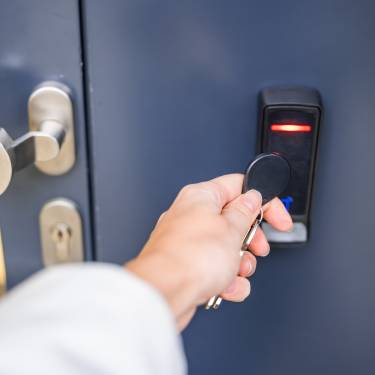
Access control is an important part of building security. If you’re deciding among access control systems for your business, you’ve probably encountered key fobs and proximity cards as two of the most popular types. But which is more secure? This blog explores the features of both security devices to help you decide.
The Virtues of Key Fobs
Key fobs are small, compact, and convenient. They can fit easily onto keychains, making them easy for employees to carry without worrying about losing them. Key fobs use uniquely encoded signals to communicate with access control systems.
From a security standpoint, key fobs offer strong encryption that prevents unauthorized duplication. Unlike traditional keys, which are easy to copy, encoding on fobs makes them more challenging to breach. Additionally, if a key fob is lost or stolen, you can deactivate it without needing to replace an entire lock system.
Ultimately, securing sensitive areas with proximity key fobs is a reliable and adaptable security solution.
The Benefits of Proximity Cards
Proximity cards also provide an effective way to control access throughout a business and eliminate the need for traditional locking mechanisms. With a simple wave or tap gesture, employees can use these cards to effortlessly enter controlled areas.
Proximity cards facilitate scalability. Many systems can tie multiple access points to one database, enabling the creation of detailed logs for tracking movement throughout a facility. Replacement of proximity cards is cost-effective, and reprogramming cards is straightforward if a breach occurs.
With their streamlined functionality and versatile applications, proximity cards are a strong contender for advanced access control systems.
Which Is More Secure?
So are key fobs or proximity cards more secure? When deciding between the two, you should evaluate your operational needs. Both technologies have robust encryption and are less vulnerable to tampering than traditional keys.
However, key fobs tend to have a slight edge in resistance to damage and being harder to lose. Meanwhile, proximity cards excel in cost-effectiveness and scalability.
Carefully considering the size of your workforce, the complexity of access points, and the importance of tracking capabilities will guide you toward the best choice for your business. Ultimately, both options deliver excellent security if you implement them correctly.
Bio: Casey is a passionate copyeditor highly motivated to provide compelling SEO content in the digital marketing space. Her expertise includes a vast range of industries from highly technical, consumer, and lifestyle-based, with an emphasis on attention to detail and readability.




















